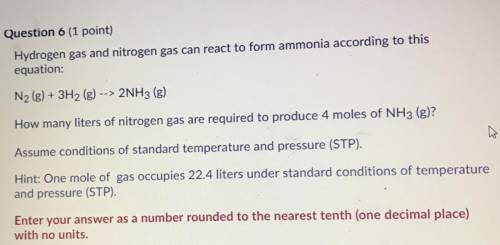
Question 6 (1 point) Hydrogen gas and nitrogen gas can react to form ammonia according to this equation: N2 (g) + m 3H2 (g) --> 2NH3(g) How many liters of nitrogen gas are required to produce 4 moles of NH3 (g)? Assume conditions of standard temperature and pressure (STP). Hint: One mole of gas occupies 22.4 liters under standard conditions of temperature and pressure (STP).


Answers: 2


Another question on Chemistry

Chemistry, 21.06.2019 23:50
Why do scientists look for patterns in the world? a. patterns can explain observations. b. patterns never change, no matter what. c. patterns are easy for scientists to detect. d. patterns are all the same, through all time.
Answers: 1

Chemistry, 22.06.2019 02:00
In the following redox reaction which is the oxidizing agent and which is the reducing agent? alcl3 + na nacl + al
Answers: 1

Chemistry, 22.06.2019 07:20
After watching the video "zinc strip in copper nitrate solution", and reading the instructions, click on the link labeled "start" just below the drawing of the pencil tip. follow the direction to complete the 3x3 grid. answer the below questions for the portion of the activity in which sn(s) is placed in agno3(aq)
Answers: 1

Chemistry, 22.06.2019 14:50
The table compares the number of electrons in two unknown neutral atoms. comparison of electrons atom number of electrons a 9 d 11 use this information to determine the number of valence electrons in the atoms. which of the following correctly compares the stability of tthe table compares the number of electrons in two unknown neutral atoms. comparison of electrons atom number of electrons a 9 d 11 use this information to determine the number of valence electrons in the atoms. which of the following correctly compares the stability of the two atoms? both are unreactive. both are highly reactive. a is unreactive and d is reactive. a is reactive and d is unreactive.
Answers: 3
You know the right answer?
Question 6 (1 point)
Hydrogen gas and nitrogen gas can react to form ammonia according to this equa...
Questions



Physics, 31.05.2020 08:57





Mathematics, 31.05.2020 08:57

Physics, 31.05.2020 08:57






Mathematics, 31.05.2020 08:57


Mathematics, 31.05.2020 08:57

Chemistry, 31.05.2020 08:57

Mathematics, 31.05.2020 08:57

Mathematics, 31.05.2020 08:57




